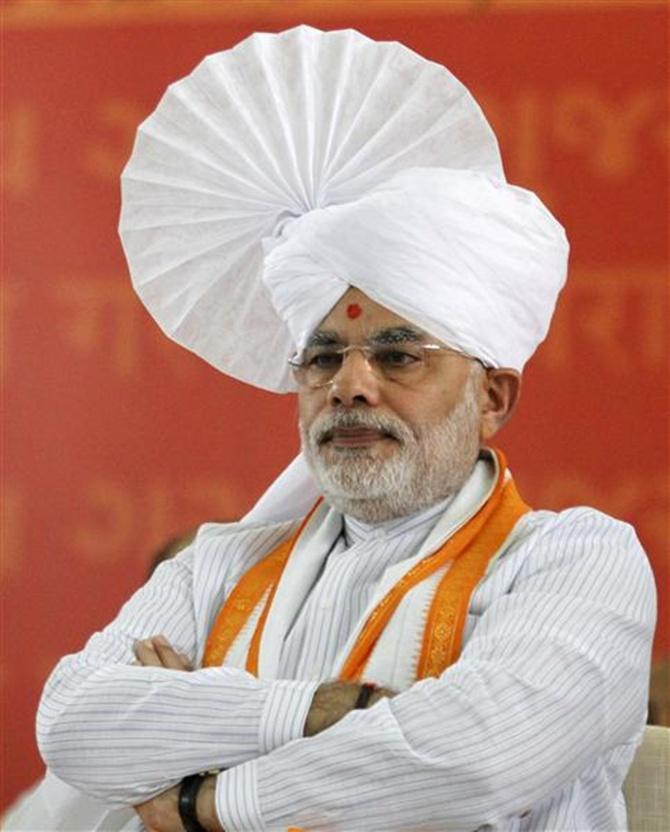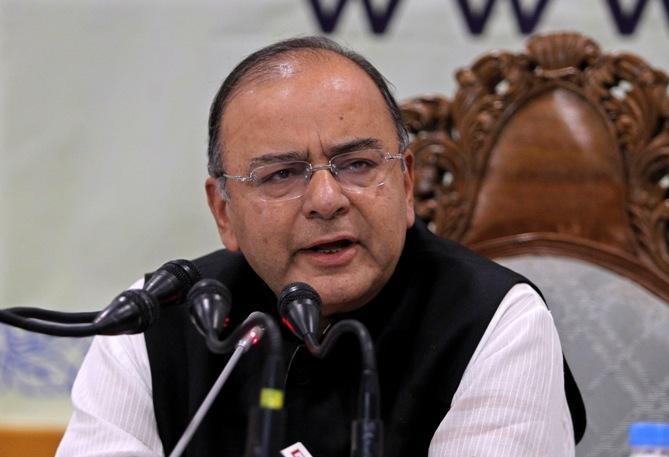Photographs: Reuters Shreekant Sambrani
There would be extraordinary pressure on the government against raising user charges, be it for services or actual goods and commodities with controlled prices, says Shreekant Sambrani.
“Power is poison,” Rahul Gandhi had said rather inexplicably even as he sought it. But Prime Minister Narendra Modi must find it a wonderful Philosopher’s Stone.
Its alchemy has converted his economic ideas from being treated as naive and poorly conceived to being hailed as pragmatic and worthy of respect.
His first major speech on the economy was before an invited audience of business executives and finance professionals on February 27 in Delhi.
He touched all the right buttons: the need to revive agriculture with due attention to water conservation and infusion of right technology, competitive manufacturing, and continued emphasis on services, the three pillars of economy. He said that India needed investment in all three, not just in industry.
Energy and infrastructure came in for special mention, especially with a futuristic orientation: infrastructure for better agricultural reach, creation of gas and water grids, and an optical fibre network, as well as increasing recourse to solar energy in the west, wind energy in the south and hydropower in the north-east.
Along the way, he expressed support for a general goods and services tax, much to the appreciation of the attentive audience.
He highlighted the role of education in realising the potential of demographic dividend, and health, especially preventive health care, in improving the quality of life.
…
Please click here for the Complete Coverage of Budget 2014 -15
Does Jaitley have the cure for India's ailing economy?
Image: Prime Minister Narendra ModiPhotographs: Reuters
Ever the sloganeer, he said that India’s unique endowment of democracy, demography and demand needed to be supplemented by three more d’s: direction, determination and dedication.
That was still only a speech by a candidate for a high office, not yet in power, no matter what it contained. One leading economic paper, not known for its partisanship of any party, editorially trashed it: “[Modi] mostly delivered alliterative buzzwords – three unconnected words starting with D, four with M, five with T...listing subjects does not a strategy make, nor for that matter a plan of action...Is he devoid of firm thoughts when it comes to the key economic challenges?”
Modi, of course, continued his onward march and five weeks later, most of what he had said was repeated nearly verbatim in the Bharatiya Janata Party (BJP) election manifesto. BJP’s handsome victory endowed these words with near-official status as the basis of the economic agenda of the new government.
That was confirmed when President Pranab Mukherjee virtually quoted the manifesto in his address to Parliament on June 9.
That addressed contained all the Modi alliterations. The editorial wisdom of the same paper the next day was that the mention of the BJP promises in “the president’s address is an assurance that the party...is keen of fulfilling its electoral promises made to the people.”
The earlier discomfort with phrasing and presumed infirmity of thought had disappeared. Almost all media comment was similarly welcoming in nature. Modi’s caution about tough choices later the same week also went down well.
As we await the Budget to see how much of the promise is acted upon, there is yet again considerable ferment about the government’s intentions and resolve.
This is the result of the hefty 14.6 per cent increase in rail fares, a much-delayed (and feared) rise in the petrol and diesel prices at the pump and a flare-up in that recent Waterloo of political parties, the vegetable market.
…
Please click here for the Complete Coverage of Budget 2014 -15
Does Jaitley have the cure for India's ailing economy?
Photographs: Sivaram V/Reuters
The media is now abuzz with speculation whether the happy days (achchhe din) that Modi promised were in fact a false dawn of hope.
Ordinarily, the media clamour on any issue is of little lasting interest, because the audience memory is in nanoseconds and today’s headlines are tomorrow’s pakora wrappers. But the present situation is far from normal, for two entirely external reasons. The first is the West Asia imbroglio following the dramatic inroads by the Islamic State of Iraq and the Levant militants leading to crude prices jumping by 15 per cent.
The second of course is the worse-than-anticipated dismal beginning of the life-sustaining monsoon in the country. The June precipitation is less than 60 per cent of the long-term average. The India Meteorological Department tells us that the monsoon will soon revive. We have been down that road before too many times to trust such reassurances!
This combination of circumstances could be considered as short-term aberrations, but it would be entirely unwise to dismiss them. Their consequences would be grave indeed.
Higher oil prices would start affecting our rather delicate balance of payments almost immediately. That would in turn cause the rupee to start sliding all over again. And if the government does not pass on the full impact of this rise to the consumers, it would strain its finances greatly.
Cutting to the chase, the Indian economy will not budge until investors return. That will not happen unless inflation is tamed. And the vital organs of that beast are in the food basket, with the heart beating to the rhythm of the greens. That is a simplification, but only just.
So however short term these adverse circumstances may be, they are the sharks in the shallows that the government must deal with. The prime minister has reacted quickly (unlike his predecessor).
…
Please click here for the Complete Coverage of Budget 2014 -15
Does Jaitley have the cure for India's ailing economy?
Photographs: Reuters
The government has not shied away from increases in fuel prices or rail fares. Whether these are justified as legacies from the previous government is irrelevant; what matters is that these unavoidable steps have been taken with acceptance of all the attendant reactions.
There is also an acceptance of the prevailing ground reality in the vegetable economy. The elephant in the room is price manipulation. That is not as surprising as it might sounds given the difficulties in hoarding perishables.
A conjectured, but nearly accurate scenario involves potatoes and onions, the two leading vegetables. Potatoes can be and are stored under controlled conditions. Onions last up to six months. A handful of traders in the three central wholesale mandis, Nasik in the growing area and Navi Mumbai and Azadpur (Delhi) in the consuming areas, rule the entire vegetable economy.
They own or control large volumes of potatoes and onions. They collusively decide the quantum and timing of stock release to stoke up prices.
The traders’ hold over their respective market extends to controlling prices of their vegetables as well, since their buyers depend on them for all their requirements. Oligopolistic cartels thus govern the entire trade chain. A welter of anecdotal as well concrete evidence is available in support of this contention.
Vegflation is no longer an aberration but a recurrent problem. Systematic, not sporadic, counter cyclical policies must be in place to check the power of the traders. Government intervention today has comprised first of raising minimum export prices of potatoes and onions.
…
Please click here for the Complete Coverage of Budget 2014 -15
Does Jaitley have the cure for India's ailing economy?
Image: Finance minister Arun JaitelyPhotographs: Danish Ismail/Reuters
As produce exports are minuscule compared to the domestic demand, its direct impact of such could be minimal, but it sends a signal of government response. Concerned officials, including the finance minister, have talked softly, but left the traders in no doubt that the government carried a big stick to make them de-hoard.
The large number of raids and imposition of the Essential Commodities Act may not immediately bring the prices down because of the usual cyclical upturn and fears of an impending drought. But they would act as strong deterrents against faster upward spiralling.
As things stand today, there would be extraordinary pressure on the government against raising user charges, be they for services or actual goods and commodities with controlled prices.
Thus opportunities of reducing the subsidy burden are limited. Nor is there much scope to increase taxes, direct or indirect, without hurting the already limping economy further.
What we can realistically expect the Budget to focus on is utmost restraint of what little discretion the government has on spending.
Thus, it must desist the temptation to place further burden on its already bloated subsidy commitments, a caution that the Manmohan Singh – Sonia Gandhi dispensation threw to the wind.
The ballooning subsidies were hidden by accounting legerdemain by its master practitioner P Chidambaram, in the guise of fiscal consolidation. The spectre of unmet and postponed commitments is one among the many far from welcome surprises Arun Jaitley has to deal with in the next few days.
It would require a braveheart to face the present economic situation. The Modi government faces its early baptism by fire. Its finely articulated vision cannot be held to ransom by populist considerations. At the same time, genuine concerns for the suffering population must not become victims of economic prudence.
I had called Modi’s February speech prime-ministerial in nature. Now that he is in that position, he must lead us to a kinder, gentler India, to recall what the first president George Bush had said in his 1988 campaign.
Happy days will be here again only when the sharks are cleared from the beaches.
Please click here for the Complete Coverage of Budget 2014 -15






article